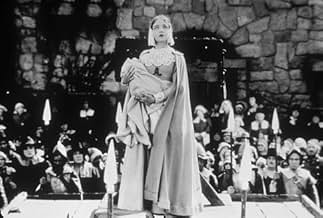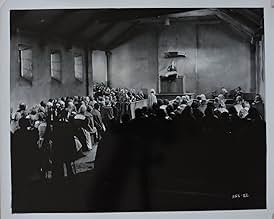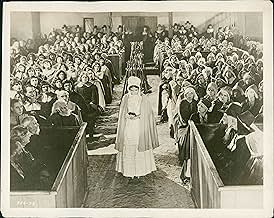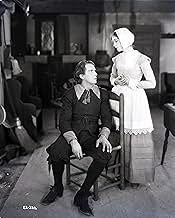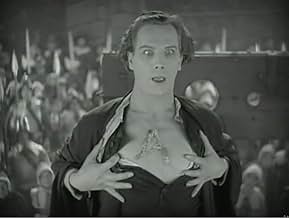CALIFICACIÓN DE IMDb
7.6/10
2.1 k
TU CALIFICACIÓN
Tras tener un hijo fuera del matrimonio, una joven puritana es presionada para que revele el nombre de su amante.Tras tener un hijo fuera del matrimonio, una joven puritana es presionada para que revele el nombre de su amante.Tras tener un hijo fuera del matrimonio, una joven puritana es presionada para que revele el nombre de su amante.
- Dirección
- Guionistas
- Elenco
- Premios
- 1 premio ganado en total
Buck Black
- Child in crowd
- (sin créditos)
Nora Cecil
- Townswoman
- (sin créditos)
Iron Eyes Cody
- Young Indian at Dunking
- (sin créditos)
Artye Folz
- Child
- (sin créditos)
Dorothy Gray
- Child
- (sin créditos)
Douglas Haig
- Minor Role
- (sin créditos)
Betsy Ann Hisle
- Child
- (sin créditos)
Opiniones destacadas
MGM's 1926 adaption of Nathaniel Hawthorne's "The Scarlet Letter" is, quite possibly, the best motion picture to have been released in the silent screen era's latter days. It can, undoubtedly, be looked upon as the best that two of that era's best actors-Lillian Gish & Lars Hanson-were paired up in. And, too, one very talented child actress, by the name of Joyce Coads, deserves to be given big credit. (She made only 10 more films before taking a final bow from the limelight; in her 2nd to last-"Devotion" 1931-she didn't get billing.) "The Scarlet Letter" should also be noted as, perhaps, the very best that Victor Seastrom- whom Charlie Chaplain had called "the best director in all the world" ever delivered. Just don't make the mistake of seeing this film as a good adaption of Hawthorne's novel. Because it's not. The film is a total of an hour and 20 minutes. Had it been really true to the novel, it just might have been longer than "Gone With The Wind." (And, speaking of the wind, as fate would have it, Seastrom directed only one more film in the US, which also teamed up Gish and Hanson: namely, "The Wind" (1928). MGM gave Seastrom his walking papers because he'd refused to give "The Wind" a happy ending. "The Scarlet Letter" of 1926 should also be seen by anyone who just might be under the mistaken impression that silent films can't leave a lasting impression.
I love this film for everything that it is. The story, the acting, the direction, everything about it is great.
The story revolves around Hester Prynne(Lillian Gish) and her love for the Reverrend Arthur Dimmesdale(Lars Hanson). Poor Hester is marked with the 'scarlet letter' when she gives birth to her lovechild with the bishop, and the bishop suffers on his own as his heart begins to fail on account of the guilt he feels.
The orchestration of this film helps a lot because the wonderful music helps you follow the story more and bring intensity. I love Lars Hanson's performance, he has the perfect profile for love scenes.
The story revolves around Hester Prynne(Lillian Gish) and her love for the Reverrend Arthur Dimmesdale(Lars Hanson). Poor Hester is marked with the 'scarlet letter' when she gives birth to her lovechild with the bishop, and the bishop suffers on his own as his heart begins to fail on account of the guilt he feels.
The orchestration of this film helps a lot because the wonderful music helps you follow the story more and bring intensity. I love Lars Hanson's performance, he has the perfect profile for love scenes.
It was a novel Hollywood didn't want to touch in the mid-1920s, even though the 1850 classic was brought to the screen six times earlier. The recently-established Will Hays office had its censorship fangs out. A story about a married woman who gets pregnant by a lover was cause for alarm for most movie studios.
Lilian Gish, one of silent film's major star, had long wanted to bring Nathaniel Hawthorne's 'The Scarlet Letter' in an updated version to the screen. Contracted to MGM in a three-picture deal, she convinced the studio's head of production, Irving Thalberg, she could deliver a tasteful version of Hawthorne's book without moralistic tongue-waggers complaining. With a script by Frances Marion, which follows the novel closely, MGM's August 1926's "The Scarlet Letter" has been praised as the best version of the book in a long-line of past and future movie adaptations.
Its success can be attributed to Gish herself, who portrays Hester Prynne. She hasn't heard from her husband who traveled overseas for several years from their Puritan Boston, Massachusetts, home in the mid-1600s. She becomes pregnant from a man whom she doesn't disclose the name. The Gish version departs from Hawthorne in a couple of major ways: the film begins a year earlier than the author's, showing her condemned to a stockade for leaping and dancing after her song bird escapes its cage. It's there where she meets the Reverend Arthur Dimmesdale (Lars Hanson). Also, the films unveils the love relationship between the minister and Hester, not keeping secret of who's the father of the baby.
Another reason for the movie's overall financial popularity is Swedish director Victor Sjostrom's unique directing. He allowed Gish the freedom to display her attractiveness by literally letting her hair down in a clandestine meeting with Dimmesdale in the woods, reflecting Hester's modernistic independence. Gish had the choice in selecting the director, and she picked Sjostrom because she "felt the Swedes were closer to the feelings of New England Puritans than modern Americans." She also favored Hanson as Dimmesdale from his 1924 performance in "The Saga of Gosta Berling." Hanson, who knew very little English, elected to speak his lines (it was a silent movie after all) in Swedish while Gish spoke English in scenes where they're together. Homesick actress Greta Garbo, recently arriving in America from Sweden after signing a contract with MGM, was a near daily presence on the set since she was comfortable speaking her native language with Hanson.
With two weeks of filming to go, Lillian found out her mother suffered a stroke in London and reportedly dying. Dorothy, her sister, urged her to catch the first boat to England to attend to her. In a near impossible request, Lillian asked Sjostrom she needed to leave in three days to travel by train to New York City, then on to a liner to London. The director didn't flitch. He designed an almost around-the-clock schedule to film all of Gish's parts-as long as the crew agreed to the grueling sleepless itinerary. The workers heartedly agreed.
"The Scarlet Letter" is still admired for Sjostrom's creation of an environmental rise en scene that underscored the film's characters' emotion and psychology by its pastoral recreation of a 17th century village. Even though the residents of Salem, MA, where the story takes place, were insulted by their forefathers' portrayal in the film, the American Film Institute nominated it as one of the most passionate motion pictures ever made as well as nominated Hester Prynne as one of movie's most admired heroes.
Lilian Gish, one of silent film's major star, had long wanted to bring Nathaniel Hawthorne's 'The Scarlet Letter' in an updated version to the screen. Contracted to MGM in a three-picture deal, she convinced the studio's head of production, Irving Thalberg, she could deliver a tasteful version of Hawthorne's book without moralistic tongue-waggers complaining. With a script by Frances Marion, which follows the novel closely, MGM's August 1926's "The Scarlet Letter" has been praised as the best version of the book in a long-line of past and future movie adaptations.
Its success can be attributed to Gish herself, who portrays Hester Prynne. She hasn't heard from her husband who traveled overseas for several years from their Puritan Boston, Massachusetts, home in the mid-1600s. She becomes pregnant from a man whom she doesn't disclose the name. The Gish version departs from Hawthorne in a couple of major ways: the film begins a year earlier than the author's, showing her condemned to a stockade for leaping and dancing after her song bird escapes its cage. It's there where she meets the Reverend Arthur Dimmesdale (Lars Hanson). Also, the films unveils the love relationship between the minister and Hester, not keeping secret of who's the father of the baby.
Another reason for the movie's overall financial popularity is Swedish director Victor Sjostrom's unique directing. He allowed Gish the freedom to display her attractiveness by literally letting her hair down in a clandestine meeting with Dimmesdale in the woods, reflecting Hester's modernistic independence. Gish had the choice in selecting the director, and she picked Sjostrom because she "felt the Swedes were closer to the feelings of New England Puritans than modern Americans." She also favored Hanson as Dimmesdale from his 1924 performance in "The Saga of Gosta Berling." Hanson, who knew very little English, elected to speak his lines (it was a silent movie after all) in Swedish while Gish spoke English in scenes where they're together. Homesick actress Greta Garbo, recently arriving in America from Sweden after signing a contract with MGM, was a near daily presence on the set since she was comfortable speaking her native language with Hanson.
With two weeks of filming to go, Lillian found out her mother suffered a stroke in London and reportedly dying. Dorothy, her sister, urged her to catch the first boat to England to attend to her. In a near impossible request, Lillian asked Sjostrom she needed to leave in three days to travel by train to New York City, then on to a liner to London. The director didn't flitch. He designed an almost around-the-clock schedule to film all of Gish's parts-as long as the crew agreed to the grueling sleepless itinerary. The workers heartedly agreed.
"The Scarlet Letter" is still admired for Sjostrom's creation of an environmental rise en scene that underscored the film's characters' emotion and psychology by its pastoral recreation of a 17th century village. Even though the residents of Salem, MA, where the story takes place, were insulted by their forefathers' portrayal in the film, the American Film Institute nominated it as one of the most passionate motion pictures ever made as well as nominated Hester Prynne as one of movie's most admired heroes.
I'm familiar with concept of the story, but didn't know any of the details of the film, so I was left gripped by it, waiting to see how it would all unfold. Lillian Gish is the lead, and Lars Hanson is the pastor who she has an affair with. Both give great performances on par with their work in The Wind, and the film does a wonderful job at dealing with the complexity of the religious themes. The scene where a bunch of town kids pelt Gish's young daughter with mud simply for being the child of an unwed mother is one of the more harrowing sequences I've seen. It's just brutally grim. Without having read the original source material, I have no idea how accurate the film is, but regardless it was really compelling and complex exploration of religion and hypocrisy.
Victor Seastrom's magnificent retelling of Hawthorne's important novel is beautifully directed with an incredible performance by Lillian Gish. It is a disgrace that this film is not available in either VHS or DVD format (and especially so since the ludicrous version with Demi Moore is).
¿Sabías que…?
- TriviaLillian Gish learned that her mother had had a stroke in London and her sister, Dorothy Gish, urged her to get there on the first available boat. When Lillian informed director Victor Sjöström of the need to finish the film quickly, he created a shooting schedule that crammed two weeks worth of shooting into three days of non-stop work. The crew worked without complaint so that she could finish the film early and catch the earliest possible train to New York.
- Citas
Mistress Hibbins: I am wrongly accused! Never hath my tongue been given to gossip!
The Governor: Falsehood! Her tongue hath wagged like the tail of a dog! Duck her again!
- Versiones alternativasIn 2000, Turner Entertainment Co. copyrighted a restored version with a musical score written by Lisa Catarineau and Mark Northam and a running time of 98 minutes. Its previous version ran 79 minutes.
- ConexionesFeatured in The 43rd Annual Academy Awards (1971)
Selecciones populares
Inicia sesión para calificar y agrega a la lista de videos para obtener recomendaciones personalizadas
- How long is The Scarlet Letter?Con tecnología de Alexa
Detalles
- Fecha de lanzamiento
- País de origen
- Sitio oficial
- Idioma
- También se conoce como
- Nathaniel Hawthorne's the Scarlet Letter
- Locaciones de filmación
- Productora
- Ver más créditos de la compañía en IMDbPro
Taquilla
- Presupuesto
- USD 430,290 (estimado)
- Tiempo de ejecución1 hora 55 minutos
- Mezcla de sonido
- Relación de aspecto
- 1.33 : 1
Contribuir a esta página
Sugiere una edición o agrega el contenido que falta

Principales brechas de datos
By what name was The Scarlet Letter (1926) officially released in India in English?
Responda
